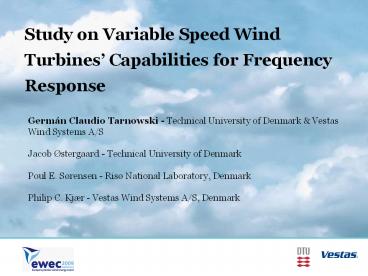Study on Variable Speed Wind Turbines - PowerPoint PPT Presentation
Title:
Study on Variable Speed Wind Turbines
Description:
Study on Variable Speed Wind Turbines Capabilities for Frequency Response Germ n Claudio Tarnowski - Technical University of Denmark & Vestas Wind Systems A/S – PowerPoint PPT presentation
Number of Views:266
Avg rating:3.0/5.0
Title: Study on Variable Speed Wind Turbines
1
Study on Variable Speed Wind Turbines
Capabilities for Frequency Response
Germán Claudio Tarnowski - Technical University
of Denmark Vestas Wind Systems A/S Jacob
Østergaard - Technical University of
Denmark Poul E. Sørensen - Risø National
Laboratory, Denmark Philip C. Kjær - Vestas Wind
Systems A/S, Denmark
2
Outline
- Introduction variable speed wind turbine
frequency response for grid frequency stability. - Simulation set-up
- Small/low inertia power system with wind power
- Models
- Simulation cases generation trip
- Conventional generation only (Base Case)
- Wind power Without inertia response
- Wind power Inertia response
- Wind power Inertia response Primary frequency
control - Conclusions remarks
3
Introduction
- Grid frequency variations ? Imbalance between
generation and consumption - Wind Turbine Frequency Response
- Change in the wind turbine active power output
as response to a change in the grid frequency - Inertia response (power from rotating kinetic
energy) - Primary frequency control (power from wind
reserve) - Study on capabilities of WT-DFIG for providing
controlled frequency response during frequency
drop in a small/low inertia power system,
combining inertia response and primary frequency
control
4
Simulation set-up WT-DFIG model
- Drive train
- 3rd order DFIG
- Converter control active and reactive power.
- Aerodynamics
- Pitch control rotational speed
5
Wind turbine frequency response
- Inertia response (inertia emulation)
- Primary frequency control (Droop)
- Plant power reserve (reserve factor)
WT control block
6
Simulation set-up Power system
Conventional generators
Capacity Inertia Type
ST1 100 MVA H 3.5 Reheat steam turbine
ST2 150 MVA H 6 Reheat steam turbine
HT 50 MVA H 5 Hydro turbine
Tripped 50 MW - -
Load 250 MW - active
50 MW Generation Loss (20)
Wind Farm replacing ST1 30 Wind Power Penetration
Capacity Type
WF 100 MVA Wind Farm
7
Simulation set-up Conventional generatorsmodel
Model for Steam Power Plant and Hydro Power Plant
8
Simulation cases Inertia response from wind
turbine
- Grid with conventional generators
- Grid without inertia response from WT
- Grid with inertia response from WT
Gen. Unit R FR ?PR MW Heq (s)
Base case ST1 6 0.3 30 5
Base case ST2 5 0.3 30 5
Base case HT 5 0.33 50 5
Case 2 WF Without inertia response Without inertia response Without inertia response 3.8
Case 3 WF Inertia response Inertia response Inertia response 5
50 MW Generation Loss (20)
9
Results Grid frequency
Grid Frequency Hz
- Conventional generators case
- WT without inertia response case
- WT with inertia response case
Frequency gradient
10
Results Power plants electric power output
Power MW
Steam turbine ST2
- Conventional generators
- Wind power without inertia response
- Inertia response from wind power
Steam turbine ST1
Wind turbine
Hydro turbine
11
WT inertia response
Powers pu
Torques pu
Rotational speed pu
Pitch angle deg
12
Simulation cases inertia response primary
frequency control
- Droop 16 Inertia response
- Droop 10 Inertia response
- Droop 9 Inertia response (Instability)
Gen. Unit R FR ?PR MW Heq (s)
Case 4 WF 16 0.1 8 5
Case 5 WF 10 0.15 12 5
Case 6 WF 9 0.15 12 5
50 MW Generation Loss (20)
13
Results Grid frequency
Grid Frequency Hz
- Conventional generators
- WT Droop 16 Inertia response
- WT Droop 10 Inertia response
Frequency gradient
14
Results Power plants electric power output
Power MW
Steam turbine ST2
- Conventional generators
- Droop 16 Inertia response
- Droop 10 Inertia response
Steam turbine ST1
Wind turbine
Hydro turbine
15
Turbine droop 10 inertia response
Powers pu
Torques pu
Rotational speed pu
Pitch angle deg
16
Turbine droop 9 inertia response. Instability.
Powers pu
Torques pu
Rotational speed pu
Grid Frequency Hz
17
Conclusions remarks
- Variable speed WTs capabilities for inertia
response and primary frequency control was
studied - Suitable control systems for variable speed WTs
need to be developed for integrating high amounts
of wind power in the grid - Grid frequency stability can be improved
combining WT inertia response and primary
frequency control - Instability in wind turbines with bad settings of
primary control and inertia response Capability
depends on the combination of droop value, power
reserve and inertia emulation.
18
Thank you for your attentionGermán C.
TARNOWSKIgct_at_elektro.dtu.dk































